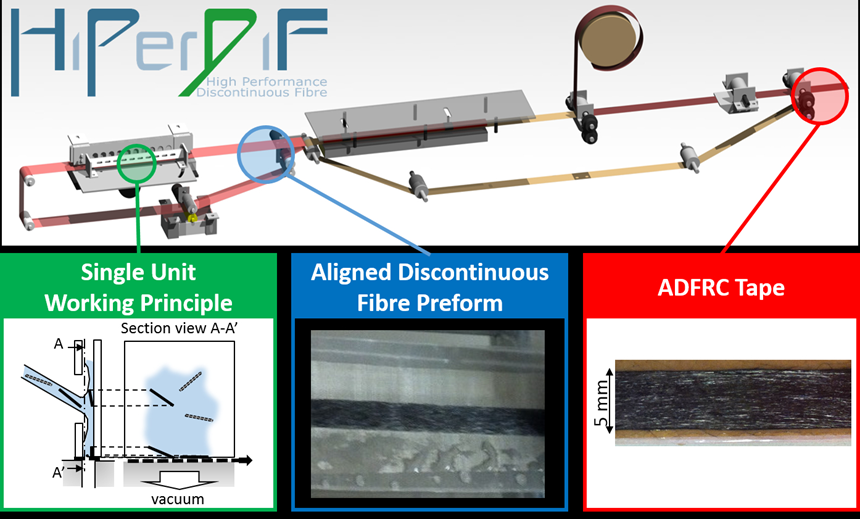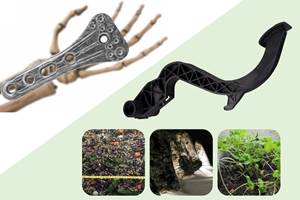U.K. research program explores aligned discontinuous fiber prepreg
A research program in the U.K. is attempting to achieve a fundamental step-change in the composites industry.
A research program in the U.K. is attempting to achieve a fundamental step-change in the composites industry. The High Performance Discontinuous Fibre project (HiPerDiF), which began in December 2017 and runs through 2020, is a program funded by the U.K.’s Engineering and Physical Sciences Research Council (EPSRC). It is exploring an alternate way to produce high-performance carbon fiber composites: start with discontinuous, rather than continuous fibers. The program, led by Professor Ian Hamerton of the Bristol Composites Institute (ACCIS) at the University of Bristol, has an impressive roster of project partners, including Airbus, Toyota, BAE Systems, ELG Carbon Fibre Ltd., Hitachi Chemical Co. Ltd. and several composite material suppliers including Solvay and Hexcel.
The HiPerDiF researchers argue that simplifying and automating manufacturing processes will increase composite part production volumes. And, if greater production volumes means using more carbon fiber, recycling processes are key to recovering and reusing the fiber. In other words, the goal is to develop a high-volume method that can readily, as the group says, “remanufacture” recycled short fibers and produce parts with mechanical properties comparable to continuous fibers, with those parts in turn (if coupled with a thermoplastic matrix) able to be recycled several times.
The program’s co-investigative lead, Dr. Marco Longana, explains that HiPerDiF technology is a high-volume manufacturing method, invented at the University of Bristol by Dr. HaNa Yu under an earlier program (HiPerDuct, or High Performance Ductile Composite Technology), that is used to produce high-performance aligned discontinuous fiber reinforced composites (ADFRC). He points out that if discontinuous fibers are accurately aligned and their length is significantly longer than the critical fiber length, then the tensile modulus, strength and failure strain of the obtained composites are comparable to those of continuous fiber composites.
The manufacturing technology, which can handle a range of synthetic and natural fibers with lengths between 1 and 12 millimeters, involves suspending the fibers in water and pumping the water/fiber mixture through a nozzle or nozzles directed toward a gap between two parallel plates. Longana explains that the fiber alignment relies on the sudden momentum change of the fiber suspension when it impacts the furthermost plate. The fibers then fall on a stainless-steel mesh conveyor belt, and the water is removed by suction. This aligned fiber preform is dried via infrared, then combined with either a thermoplastic or thermoset resin to form a prepreg. According to the paper explaining the process, the initial machine prototype produced specimens with 67 percent of the fibers within a ±3° range from unidirectional. By processing 3 millimeter, high-strength carbon fiber, a stiffness of 115 GPa, a strength of 1,510 MPa, and a failure strain of 1.41 percent was achieved, with specimens under tensile load.
The HiPerDiF technology can be used to tailor mechanical behavior of composite materials, via hybridization with glass fibers. The researchers also note that reclaimed fiber, while preserving its stiffness, suffers due to sizing removal, alteration of the fiber surface due to char formation and loss of surface activation that affects fiber/matrix adhesion. HiPerDiF is therefore well-suited for assembling reclaimed fibers into an economically valuable material with high mechanical properties. Hamerton adds that one of the key characteristics that differentiates this work from other projects is the ability to generate high-performance composites from recyclate, potentially recovering both mechanical characteristics and value. This program bodes well for reducing the costs of composites, and carbon fiber.
Learn more details about this project on the Engineering and Physical Sciences Research Council’s webpage
Related Content
Syensqo becomes new Solvay specialty materials company
Syensqo represents what was Solvay Composite Materials, focused on delivering disruptive material technologies and supporting growing customer needs.
Read MoreTU Munich develops cuboidal conformable tanks using carbon fiber composites for increased hydrogen storage
Flat tank enabling standard platform for BEV and FCEV uses thermoplastic and thermoset composites, overwrapped skeleton design in pursuit of 25% more H2 storage.
Read MoreBioabsorbable and degradable glass fibers, compostable composite parts
ABM Composite offers sustainable options and up to a 60% reduction in carbon footprint for glass fiber-reinforced composites.
Read MoreTPI manufactures all-composite Kenworth SuperTruck 2 cab
Class 8 diesel truck, now with a 20% lighter cab, achieves 136% freight efficiency improvement.
Read MoreRead Next
Plant tour: Daher Shap’in TechCenter and composites production plant, Saint-Aignan-de-Grandlieu, France
Co-located R&D and production advance OOA thermosets, thermoplastics, welding, recycling and digital technologies for faster processing and certification of lighter, more sustainable composites.
Read MoreAll-recycled, needle-punched nonwoven CFRP slashes carbon footprint of Formula 2 seat
Dallara and Tenowo collaborate to produce a race-ready Formula 2 seat using recycled carbon fiber, reducing CO2 emissions by 97.5% compared to virgin materials.
Read More“Structured air” TPS safeguards composite structures
Powered by an 85% air/15% pure polyimide aerogel, Blueshift’s novel material system protects structures during transient thermal events from -200°C to beyond 2400°C for rockets, battery boxes and more.
Read More
























